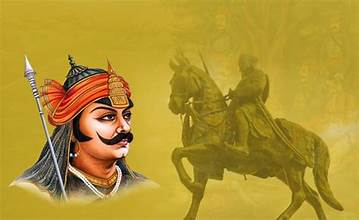Maharana Pratap, a name synonymous with unwavering valor and indomitable spirit, continues to be an emblematic figure in Indian history. His reign as the King of Mewar, a period extending from 1572 to 1597, is etched in history as an era of fierce defiance and poignant tragedy. Even centuries after his demise on January 19, 1597, Maharana Pratap’s legend, particularly his role in the iconic Battle of Haldighati, resonates in the hearts of many.
Early Life and Ascension to Power
Born into Rajput royalty in 1540 at the majestic Kumbhalgarh fortress in Rajasthan, Pratap was meticulously groomed for leadership and combat under the watchful eye of his mother, Maharani Jaivanta Bai. Succeeding his father, Uday Singh II, at the age of 32, he was immediately confronted with a colossal challenge – the expansionist aspirations of the Mughal Empire, under the rule of Emperor Akbar.
The Battle of Haldighati: A Testament to Courage
The year 1576 marked a significant chapter in Maharana Pratap’s reign with the fierce Battle of Haldighati. Despite being heavily outnumbered, Maharana Pratap and his valiant Mewar army engaged in a ferocious conflict against the Mughals in the daunting terrains of a mountain pass. Although the Mughals, led by Akbar, claimed a tactical victory, they fell short of capturing Pratap, who, aided by his legendary steed Chetak, managed a daring escape, embodying the essence of resilience and tenacity.
Maharana Pratap and Chetak: A Legendary Bond
The story of Maharana Pratap is incomplete without mentioning his faithful horse, Chetak. In the heat of the Battle of Haldighati, a critical moment came when Chetak, despite suffering a grave injury caused by the tusks of an enemy elephant, heroically carried the injured Maharana away from the battlefield, ensuring his safety. This act of loyalty and bravery has been celebrated in countless folklores and songs, cementing Chetak’s place in history alongside his master.
Reclamation and Resistance
Post-Haldighati, while the symbolic heart of Mewar, Chittor, remained out of reach, Maharana Pratap managed to regain control over significant territories. His determination and refusal to bow to Mughal dominance stood as a beacon of resistance. His son, Amar Singh I, later negotiated a truce with the Mughals, symbolizing a blend of valiant resistance and pragmatic diplomacy.
Legacy and Inspiration
Maharana Pratap’s life and struggles have transcended time, becoming a source of inspiration for generations. His unwavering commitment to principles, his dedication to his land and people, and his refusal to accept subjugation have made him a symbol of resistance and heroism. Every year, on his death anniversary, people pay homage to this iconic figure through various cultural events and discussions, remembering and celebrating his extraordinary life and enduring legacy.
Enduring Influence and Cultural Significance
Maharana Pratap’s narrative continues to inspire those who cherish the values of courage, integrity, and patriotism. His life story, rich in lessons of bravery and resilience, is not just a chapter in history books but a source of motivation for individuals standing against oppression and fighting for their beliefs.




